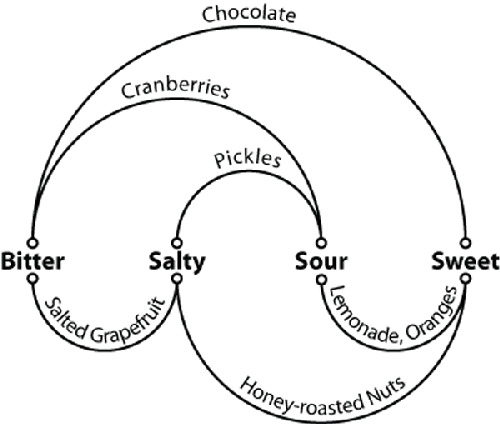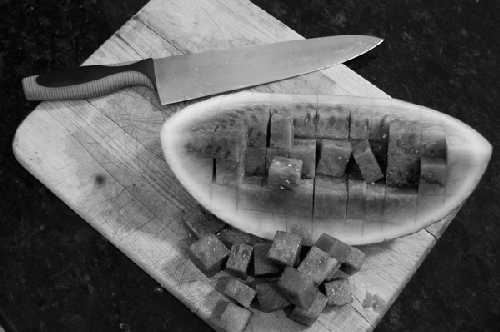6. Others
In addition to the primary sensations of taste, our taste buds also respond to oral
irritation brought about by hot peppers (typically from the chemical capsaicin), cooling
sensations (typically menthol from plants like peppermint), and carbonation. The reaction
to hot peppers is governed by a neurotransmitter called substance P
(P is for pain; go figure). In one of nature’s more subtle moves,
substance P can be depleted slowly and takes time—many days, possibly weeks—to replenish,
meaning that if you eat hot foods often, you literally build up a tolerance for hotter and
hotter foods as your ability to detect their presence goes down. Because of this, asking
someone else if a dish is spicy won’t always tell you if it’s safe to jump in. Carbonation
in soft drinks also irritates the taste buds, but in a different way that stimulates
the somatosensory
system. Carbonation also interacts with an enzyme (carbonic anhydrase 4) to trigger our
sour taste receptors, but for now it’s unclear as to why it doesn’t actually taste sour to
us.
Our mouths also capture data for a few chemical families present in some foods, along
with noticing texture and “mouthfeel.” Some of the sensations picked up by our mouths
include pungency, astringency, and cooling. Pungency is commonly described as being like
some strong, stinky French cheeses: a sharp, caustic quality. Astringency results when
certain compounds literally bind to taste receptors and causes a drying, puckering
reaction. Astringent foods include persimmon, some teas, and lower-quality pomegranate
juices (the bark and pulp are astringent). Cooling is the easiest to understand: the
chemical menthol, which occurs naturally in mint oils from plants such as peppermint,
triggers the same nerve pathways as cold. Menthol is commonly used in chewing gum and mint
candies.
Different cultures give different weights to some of the sensations listed here.
Ayurvedic practices on the Indian subcontinent include food recommendations as part of
their prescriptions, defining six types of taste: sweet, sour, salty, warm (like “hot” but
not the same kind of kick), bitter, and astringent. No umami, but two additional
variables: warm and astringent. Thai cooking also defines hot as a primary taste. For most
European cuisines, these additional variables are of lesser importance, possibly due to
genetic differences in taste receptors related to supertasting between Europeans and
Asians.
Your reaction to a particular taste is based in part on your prior experiences with
similar flavors. Have prior exposures been pleasant, or revolting? Taste aversions—a
strong dislike for a food, but not one based on an innate biological
preference—typically stem from prior bad experiences with food. Sometimes only a single
exposure that results in foodborne illness (and usually an unpleasant night near the
bathroom) is all that it takes for your brain to create the negative association. The food that triggers the illness is correctly identified only part of the time.
Typically, the blame is pinned on the most unfamiliar thing in a meal (this is known as
sauce béarnaise syndrome). Sometimes the illness isn’t even food-related, but a negative
association is still learned and becomes tied to the suspected culprit. This type of
conditioned taste aversion is known as “the Garcia Effect.” As further proof that we’re
at the mercy of our subconscious, consider this: even when we know we’ve misidentified
the cause of an illness (“It couldn’t be Tim’s mayonnaise salad, because everyone else
had it and they’re fine!”), an incorrectly associated food aversion will still
stick. One of the cleverest examinations of taste aversion was done by Carl Gustavson as a
grad student stuck at the ABD (all but dissertation) point of his PhD. Reasoning that
taste aversion could be artificially induced, he trained free-ranging coyotes to avoid
sheep by leaving (nonlethally) poisoned chunks of lamb around for the coyotes to eat.
They soon learned that the meat made them ill, and thus “learned” to avoid the sheep. I
don’t recommend this method for kicking a junk food habit or keeping your coworkers from
stealing unmarked food from the company fridge, as tempting as it might be. |
7. Combinations of Tastes and Smells
Most dishes involve a
combination of ingredients that contain at least two different primary tastes, because the
combination brings balance and adds depth and complexity. Whether the dish is a French
classic or a simple item of produce, the taste will be simple (“one note”) unless it’s
paired with at least one other.
To alter the flavor of fresh fruit, you can sprinkle it with sugar (try this on
strawberries) or salt (on grapefruit), wet it with lime juice (papaya, watermelon, peaches
with honey), or combine it with an ingredient from another taste family (sweet watermelon
and salty feta cheese). If you can find fresh papaya, try slicing it and sprinkling a bit
of cayenne pepper and salt on top of the pieces for a salty/sweet/hot combination. Try
replacing the papaya with other tropical fruits and the cayenne pepper with other hot
items. Guava and chili pepper? Mango salad with jalapeños and cilantro? Strawberries and
black pepper?
Note:
Black pepper has no capsaicin (the chemical that gives cayenne pepper and jalapeños
their heat) but is still pungent due to another chemical, piperine.
For another twist, try mixing foods high in fats with hot ingredients. They should
pair well with ingredients that contain capsaicin, because capsaicin is fat soluble.
Experiment with avocado and sriracha sauce, commonly known as rooster
sauce for the drawing on the bottle of one popular brand.
Note:
Rooster sauce (sriracha sauce—Thai hot sauce), it has been said, can improve the
taste of any dorm food, but beware, it’s spicy. As one friend
quipped to me, it’ll hit you like a freight train and then leave like a freight
train.
For you visual thinkers, here’s a diagram of the combinations of the
four basic flavors, with a few foods labeled for each combination. Ask yourself:
what other foods have these combinations? When cooking, think about which tastes
your dish emphasizes and in which direction you want it to go.

Many
foods are combinations of three or more primary tastes. Ketchup, for example, is
surprisingly complex, with tastes of umami (tomatoes), sourness (vinegar), sweetness
(sugar), and saltiness (salt).
Taste combinations are equally important in drinks. The hallmark of a well-mixed
cocktail is the balance between bitter (bitters) and sweet (sugar). Likewise, unless
you’ve learned to enjoy bitterness, coffee and tea (slightly bitter) are commonly combined
with sweeteners (milk, sugar, honey) or acidifiers (lemon juice, orange juice) to balance
out the tastes.
In some cases, the combination of different primary tastes is achieved by serving two
separate components together, pairing one dish with a second on the basis that the two
will complement each other. In Indian food, for example, the salty sweetness of a yogurt
lassi balances out the spicy hotness of curries. Consider the following combinations of
primary flavors. With the exception of bitter/salty, every pair of primary tastes is a
common combination.
|
Combination
|
Single-ingredient example
|
Combination example
|
|---|
|
Salty + sour
|
Pickles
Preserved lemon peel
|
Salad dressings
|
|
Salty + sweet
|
Seaweed (slightly sweet via mannitol)
|
Watermelon and feta cheese
Banana with sharp cheddar cheese
Cantaloupe and prosciutto
Chocolate-covered pretzels
|
|
Sour + sweet
|
Oranges
|
Lemon juice and sugar (e.g., lemonade)
Grilled corn with lime juice
|
|
Bitter + sour
|
Cranberries
Grapefruit (sour via citric acid; bitter via naringin)
|
Negroni (cocktail with gin, vermouth, Campari)
|
|
Bitter + sweet
|
Bitter parsley
Granny Smith apples
|
Bittersweet chocolate
Coffee/tea with sugar/honey
|
|
Bitter + salty
|
(N/A)
|
Sautéed kale with salt
Mustard greens with bacon
|
If it’s summertime and you’re able
to get good watermelon, try this simple salad to experience the contrast in flavors
between the salt in feta cheese and the sweetness of watermelon.
In a bowl, toss to coat:
2 cups (300g) watermelon, cubed or
scooped
½ cup (120g) feta cheese, cut into small
pieces
¼ cup (40g) red onion, sliced super thin, soaked and
drained
1 tablespoon (14g) olive oil (extra virgin because it
imparts flavor)
½ teaspoon (3g) balsamic vinegar
Notes
Try using a teaspoon or two of lime juice, instead of vinegar, as the
source of acidity. Alternatively, play with the tastes by adding black olives
(salty), mint leaves (cooling), or red pepper flakes (hot), thinking about how
each variation pushes the tastes in different directions.
There is some evidence that suggests our taste receptors can interact
with the capsaicin in hot peppers (for you bio geeks, via TRPM5) and possibly
menthol in mint (via TRPM8), but these interactions are not yet well understood in
the science domain, let alone the culinary world.
Always soak onions that will be served raw. When cut, an enzyme
(allinase) reacts with sulfoxides from the onion’s cells to produce sulfenic acid,
which stabilizes into a sulfuric gas (syn-propanethial-S-oxide) that can react
with water to produce sulfuric acid. This is why we cry when cutting onions: the
sulfuric gas interacts with the water in our eyes (the lacrimal fluid) to generate
sulfuric acid, which triggers our eyes to tear up to flush the sulfuric acid.
Because sulfides are water soluble, soaking the cut onions removes most of the
undesirable odors. You can soak them in water, or try vinegar to impart a bit of
additional flavor. Also, cutting onions in a wet environment provides liquid for
the sulfur compounds to dissolve into. Try pulling off the onion skin under water
and then cutting with a wet blade on a rinsed-but-not-dried cutting board. Another
method to reduce tearing is to chill the onion, because this makes the cell
structures firmer and reduces the amount of intra-cellular fluid available for the
allinases to react with.
If you’re lazy, skip cubing the watermelon and feta and instead serve
a slice of watermelon alongside a slice of feta, and alternate back and forth. You
can also make appetizers by skewering a cube of watermelon and a cube of feta with
a toothpick.
Dicing a watermelon is easier and faster than using a melon baller.
Using a knife, make a series of parallel slices in one direction, and then repeat
for the other two axes.
